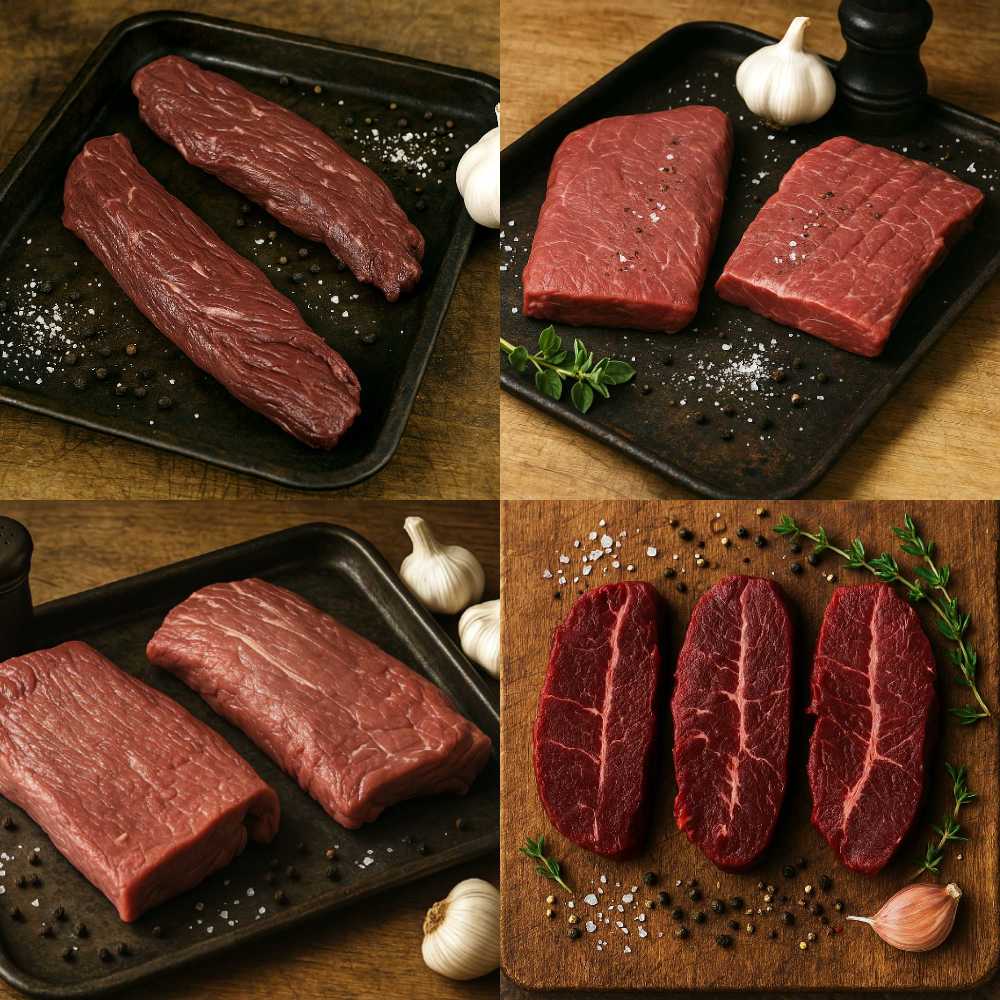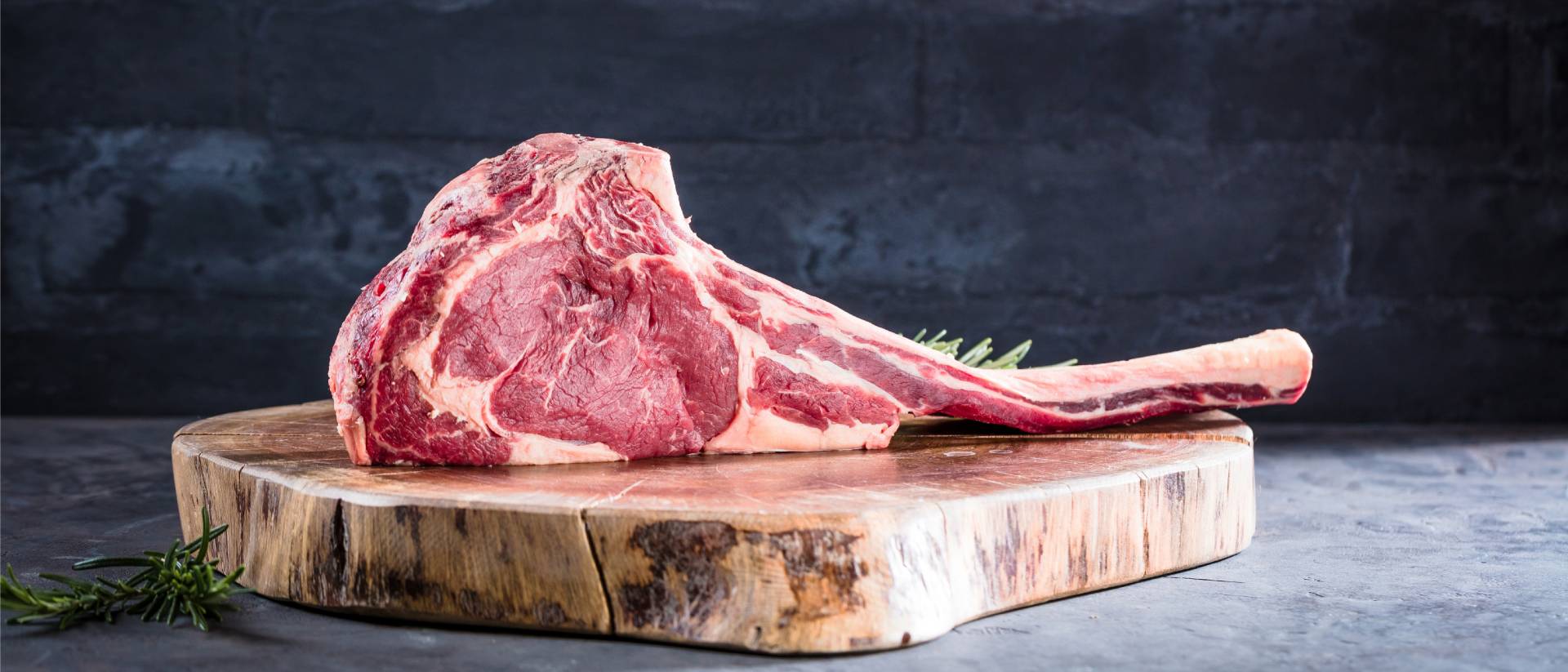
In this guide, we'll explore the nuances that distinguish a succulent Ribeye from a lean Sirloin, the buttery tenderness of Fillet and the robustness of a T-Bone. Understanding these cuts will not only enhance your appreciation for this kitchen staple but also equip you with the knowledge to select, cook, and enjoy steaks to their fullest potential. Whether grilled, pan-seared, or roast, join us in celebrating the art and science behind crafting the perfect steak.
Fillet Steak
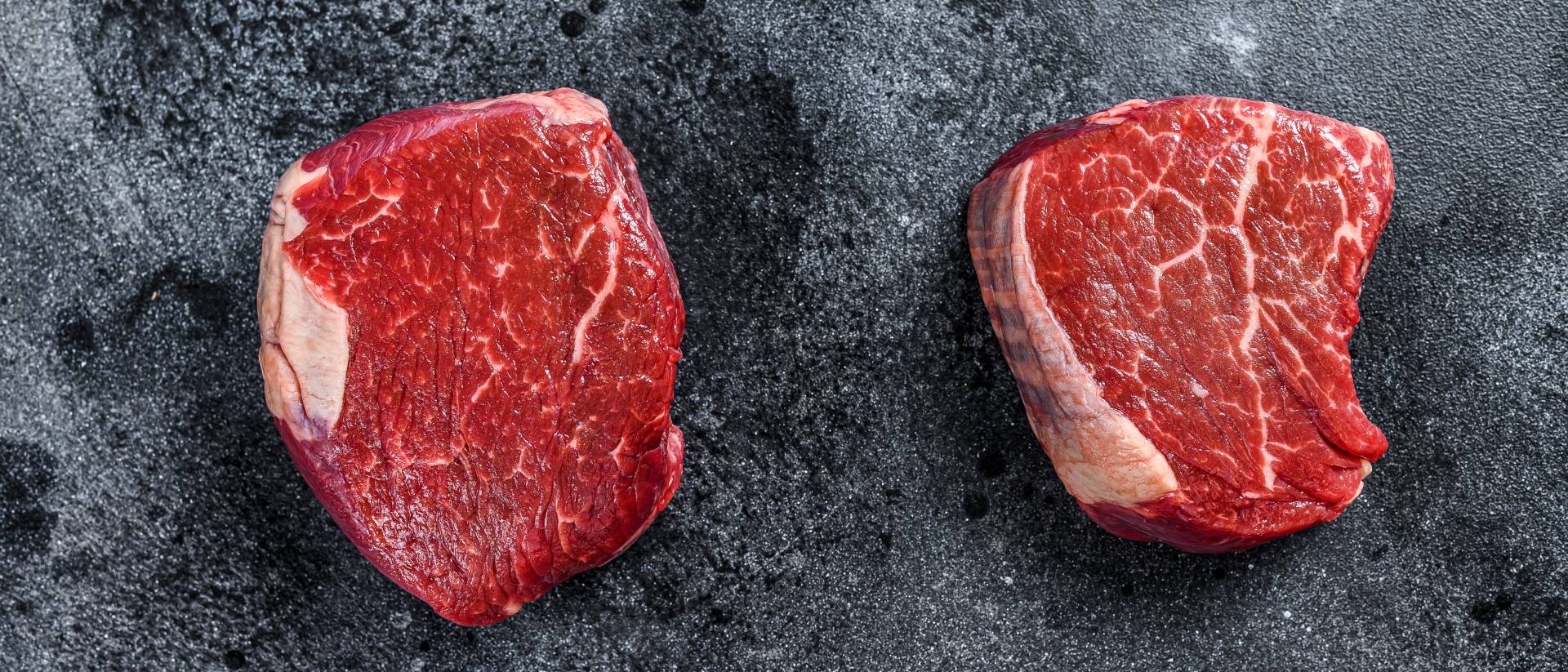
Description: Fillet steak is prized for its tenderness and subtle flavour. This cut comes from the less exercised underbelly of the cow, resulting in a texture that is almost buttery. Fillet steaks are often considered the most luxurious and sought-after beef cut due to their premium quality and tenderness.
Characteristics:
- Tenderness: The fillet is the most tender cut of beef, offering a very soft and succulent eating experience.
- Lean: It's one of the leanest beef cuts, containing minimal fat, which contributes to its mild flavour.
- Shape and Size: Fillet steaks are typically smaller and more compact than other steak cuts, often served in thicker portions to appreciate their tenderness fully.
Best For: Fillet steak is best cooked using methods that highlight its delicate texture and flavour:
- Pan-Searing: Quickly searing the steak on a high heat in a skillet to develop a crust, then finishing it on a lower heat until it reaches the desired doneness.
- Grilling: Cooking over direct high heat for a short time, given its lean nature, to avoid overcooking and drying out the meat.
- Oven: An effective method for achieving a sear without a grill, keeping a close eye to ensure the steak does not overcook.
Cooking Tips:
- Season the steak just before cooking to avoid drawing out moisture, using just salt and pepper to complement its natural flavours.
- Considering its lean composition, careful monitoring is crucial to prevent overcooking. Fillet steaks are best enjoyed rare to medium-rare, which showcases their tenderness.
- Let the steak rest for several minutes after cooking to allow juices to redistribute, ensuring a moist and tasty bite.
Serving Suggestions:
- Sauces: Classic sauce accompaniments like béarnaise, peppercorn, or a red wine reduction can add depth without overpowering the steak's subtle flavour.
- Sides: Light sides such as steamed vegetables, a simple salad, or new potatoes work well, maintaining the focus on the steak.
- Wine Pairing: A light to medium-bodied red wine, such as Pinot Noir or Merlot, complements the fillet steak without overwhelming its taste.
The fillet steak's unmatched tenderness and lean profile make it a top choice for a special occasion or indulgent meal, providing a luxurious dining experience.
Sirloin Steak

Description: The sirloin steak is a popular beef cut known for its robust flavour and satisfying texture. It's sourced from the rear back portion of the animal, lying between the tenderloin and the rib. The sirloin is divided into two main types: the top sirloin, which is more tender, and the bottom sirloin, which is larger and slightly tougher. Sirloin steaks offer a good balance of meaty flavour and tenderness without the premium price tag of cuts like the fillet.
Characteristics:
- Texture and Flavour: Sirloin steaks have a beefier flavour compared to the fillet, with a slightly firmer texture that's still tender enough to provide a satisfying chew.
- Marbling: They feature moderate marbling, contributing to their juiciness and flavour when cooked.
- Versatility: Sirloin is versatile in its preparation, suitable for a variety of cooking methods and dishes.
Best For: Sirloin steaks are well-suited to:
- Grilling: The classic method for cooking sirloin, achieving a charred exterior while maintaining a juicy interior.
- Pan-Frying: Searing in a hot pan with a bit of oil to develop a rich, caramelised crust.
- Oven: An alternative to grilling, broiling sirloin steaks in the oven can yield similarly delicious results.
Cooking Tips:
- Allow the steak to reach room temperature before cooking to ensure even cooking.
- Season generously with salt and pepper before cooking to enhance the natural flavours of the beef.
- To avoid toughness, avoid cooking sirloin steaks beyond medium doneness. Use a meat thermometer to ensure accuracy, aiming for an internal temperature of 52-57°C (125-135°F) for medium-rare.
- Let the steak rest for a few minutes after cooking to allow juices to redistribute, ensuring a moist and tender bite.
Serving Suggestions:
- Sauces: A peppercorn sauce, chimichurri, or a simple compound butter can add richness and depth to the steak.
- Sides: Sirloin pairs well with a wide range of sides, from roasted vegetables and mashed potatoes to fresh salads and grilled corn.
- Wine Pairing: A full-bodied red wine like a Cabernet Sauvignon, Shiraz, or a Malbec complements the meaty flavour of sirloin, enhancing the overall dining experience.
Sirloin steak stands out as a versatile option that balances quality and value, making it a favourite among steak lovers for both everyday meals and special occasions.
Ribeye Steak
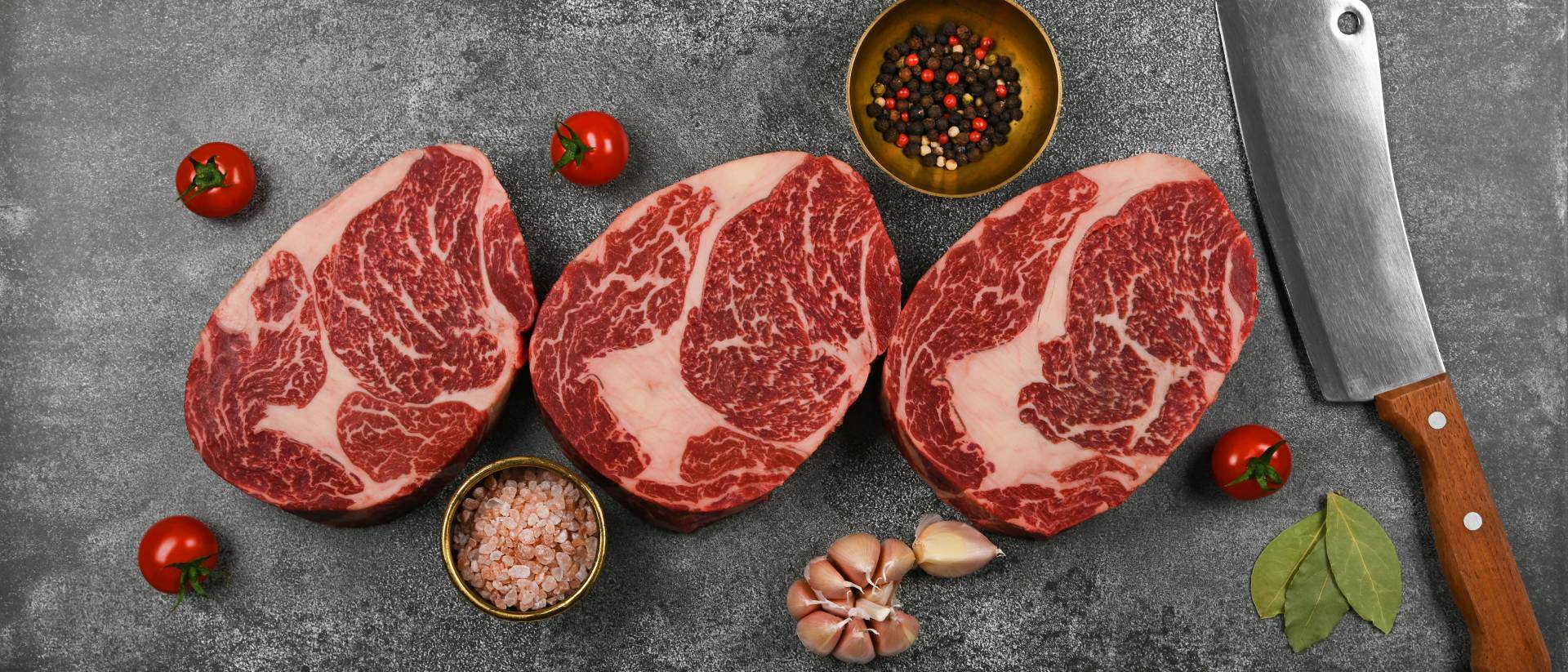
Description: The ribeye steak, known for its rich marbling and deep flavour, is one of the most prized cuts of beef. Sourced from the rib section of the cow, this cut includes some of the most beefy and fatty meat, making it incredibly tender and juicy when cooked. The ribeye can be purchased with or without the bone, with bone-in versions often referred to as rib steaks.
Characteristics:
- Marbling: Ribeye steaks are characterized by their high degree of marbling, which melts during cooking to baste the meat from within, resulting in a tender steak.
- Texture: Offers a perfect balance of meaty texture and succulence, with the fat rendering to create a buttery softness.
- Flavour: The extensive marbling contributes to its rich, beefy flavour, making it a favourite among steak enthusiasts.
Best For: Ribeye steaks excel with cooking methods that highlight their natural juiciness and flavour:
- Grilling: The high fat content makes ribeye ideal for grilling, where the flames can char the exterior while keeping the interior moist and tender.
- Pan-Searing: Cooking in a hot skillet creates a delicious crust on the outside of the steak while maintaining a juicy interior.
- Oven: An effective method for achieving a caramelized exterior without a grill, allowing for a similar depth of flavour.
Cooking Tips:
- Preheat your cooking surface to ensure a good sear that seals in flavours.
- Season the steak generously with salt and pepper before cooking to enhance its natural taste.
- Due to its fat content, it's best not to cook a ribeye beyond medium to preserve its tenderness and juiciness. Aim for an internal temperature of 51-57°C (125-135°F) for medium-rare.
- Let the steak rest for several minutes after cooking to allow the juices to redistribute throughout the meat, ensuring every bite is as delicious as the first.
Serving Suggestions:
- Sides: Classic sides like roasted potatoes, creamed spinach, or a simple arugula salad complement the richness of the ribeye.
- Sauces: While ribeye is tasty enough on its own, sauces such as béarnaise, blue cheese, or a simple red wine reduction can add an extra layer of taste.
- Wine Pairing: A robust red wine like Cabernet Sauvignon, Zinfandel, or Bordeaux stands up well to the rich flavours of the ribeye, making for a perfect pairing.
The ribeye steak is a luxurious option for those seeking a tender, juicy, and flavour-packed meal, embodying the essence of what many consider the perfect steak experience.
Côte de Boeuf

Description: Côte de Boeuf is a French term that refers to a rib steak or ribeye steak still attached to the rib bone, essentially a thick-cut, bone-in ribeye. This cut is celebrated for its rich marbling of fat, which renders down during cooking to create a succulent, flavourful, and tender piece of meat. It's a showstopper of a steak, usually large enough to serve two people, making it a popular choice for special occasions or romantic dinners.
Characteristics:
- Marbling: High levels of intramuscular fat contribute to its moist and tender texture after cooking.
- Bone-In: The rib bone is left in, which enhances the meat's flavour when cooked.
- Size: Typically large and thick, making it ideal for sharing.
Best For: Côte de Boeuf is best cooked using methods that allow its fat to render properly while keeping the inside juicy and pink. Grilling and roasting are the most popular methods, with the following approaches recommended:
- Grilling: Preheat your grill to a high temperature. Season the steak generously with salt and pepper. Sear the steak on all sides to develop a crust, then move it to a cooler part of the grill to cook indirectly until it reaches your desired doneness. Let it rest before carving.
- Roasting: Start by searing the steak in a hot pan on the stovetop to brown all sides. Then, transfer it to a preheated oven (around 200°C or 390°F) and roast until it reaches your preferred level of doneness. Resting after roasting is crucial to ensure juices redistribute throughout the meat.
Serving Suggestions: Côte de Boeuf pairs wonderfully with classic steak accompaniments:
- Sides: Roasted potatoes, grilled asparagus, sautéed mushrooms, or a simple green salad.
- Sauces: Bearnaise, peppercorn, or a simple red wine reduction can elevate the dish further.
- Wine Pairing: A full-bodied red wine, such as Bordeaux, Cabernet Sauvignon, or a robust Syrah, complements the rich flavours of the meat.
Côte de Boeuf is a luxurious and indulgent cut, perfect for those occasions when you want to impress and enjoy a decadent meal.
Rump Steak

Description: Rump steak is a popular beef cut known for its rich flavour and firm texture. It's taken from the hindquarter of the cow, specifically the section where the leg meets the loin. In the UK, rump steak is highly regarded for its deeper beef taste compared to other cuts. It's a leaner option but still offers a good amount of marbling, providing both flavour and tenderness when cooked correctly.
Characteristics:
- Texture and Flavour: Rump steak is less tender than cuts like fillet or ribeye but compensates with a more pronounced beefy flavour. Its texture provides a satisfying chew without being overly tough.
- Marbling: Contains moderate marbling, which helps keep the steak juicy during cooking.
- Versatility: Well-suited for various cooking methods and great for grilling, pan-frying, and broiling.
Best For:
- Grilling: High heat can sear the exterior to create a crust while keeping the inside moist.
- Pan-Frying: Cooking in a skillet with butter or oil allows for an even sear and the opportunity to baste the steak, adding flavour.
- Oven Grill: A good option for achieving a charred exterior without a grill.
Cooking Tips:
- Let the steak reach room temperature before cooking to ensure even heat distribution.
- Season well with salt and pepper to enhance its natural beefy flavours. Herbs and spices can also be added according to preference.
- Avoid overcooking; rump steak is best enjoyed medium-rare to medium to maintain tenderness and juiciness. Use a meat thermometer to check for doneness, aiming for an internal temperature of around 52-57°C (125-135°F) for medium-rare.
- Rest the steak after cooking for a few minutes to allow juices to redistribute, ensuring a more tender and juicy steak upon slicing.
Serving Suggestions:
- Sides: Pair with classic steak accompaniments like chunky chips, sautéed mushrooms, grilled tomatoes, or a crisp green salad.
- Sauces: Complement with a peppercorn sauce, mushroom sauce, or chimichurri for added flavour.
- Wine Pairing: A full-bodied red wine such as Shiraz, Malbec, or a Cabernet Sauvignon pairs beautifully, cutting through the richness of the meat.
Rump steak offers a fantastic balance of flavour, texture, and value, making it a favourite for many who appreciate a hearty beef experience. With proper cooking and pairing, it can make for an exceptionally satisfying meal.
T-Bone Steak
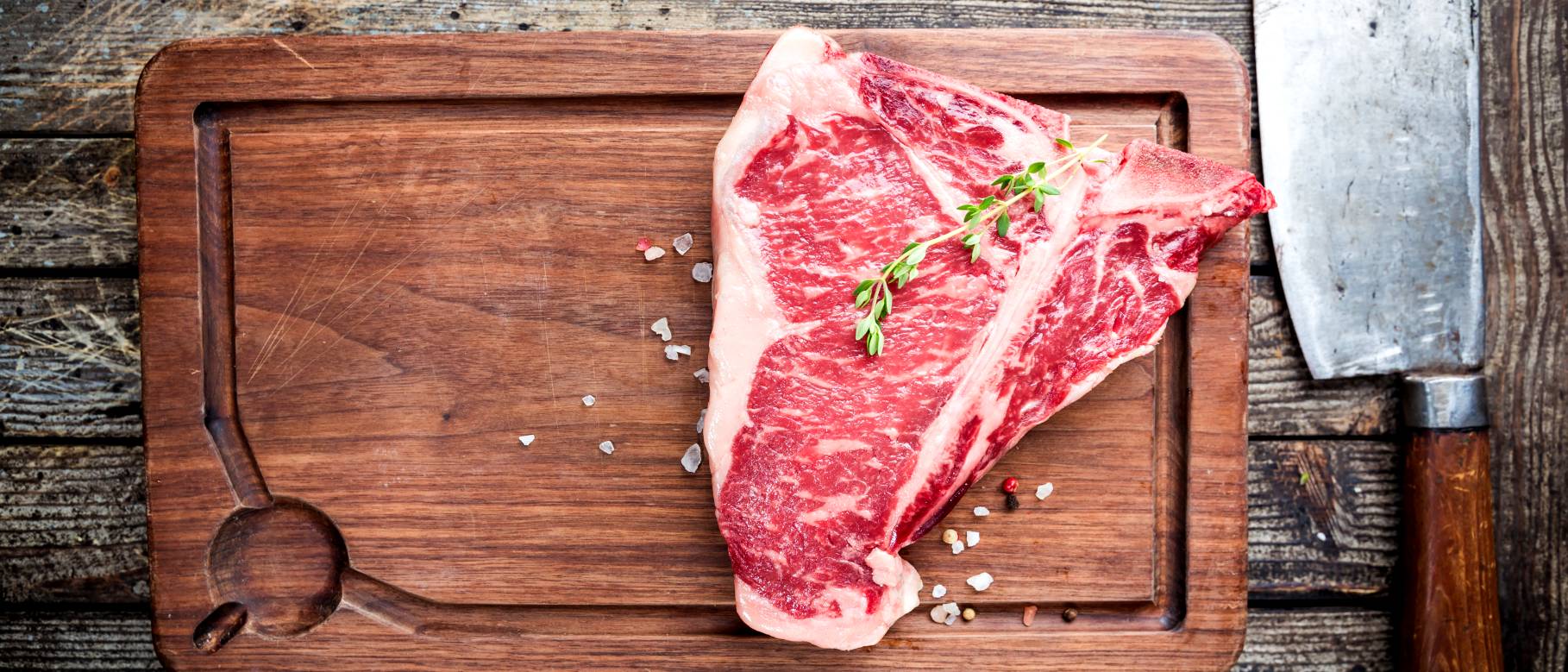
Description: The T-bone steak is a premium cut that combines two of the most prized beef cuts in one: the fillet on one side of the bone and the sirloin on the other. Named for its distinctive T-shaped bone, this cut offers a unique dining experience, providing both the buttery tenderness of the fillet and the beefy flavour of the sirloin. It's cut from the short loin section of the beef.
Characteristics:
- Texture and Flavour: The T-bone steak offers a contrast in textures and flavours, with the fillet side being soft and mild and the sirloin side offering a denser, more tasty chew.
- Size: It's a large steak, making it suitable for sharing or for those with a hearty appetite.
- Bone: The bone in the middle not only adds to the visual appeal but also enhances the steak's flavour during cooking.
Best For: T-bone steaks are best prepared using high-heat cooking methods to achieve a desirable crust on the outside while keeping the inside tender and juicy:
- Grilling: Ideal for achieving a smoky flavour and charred exterior. The bone helps conduct heat within the meat for more even cooking.
- Pan-Searing: A hot cast-iron skillet can give the T-bone steak a perfect sear and crust. Finishing in the oven may be necessary for thicker cuts to reach the desired doneness without burning the outside.
- Oven: An effective method for cooking T-bone steak to perfection, especially when outdoor grilling isn't an option.
Cooking Tips:
- Allow the steak to come to room temperature before cooking to ensure even cooking.
- Season generously with salt and pepper to enhance the natural flavours of both the tenderloin and sirloin.
- Cook over high heat to sear the outside quickly, then reduce the heat if necessary to reach the desired internal temperature without overcooking.
- Use a meat thermometer to check for doneness, aiming for 52-57°C (125-135°F) for medium-rare.
- Rest the steak for at least 5 minutes after cooking to allow the juices to redistribute, ensuring a moist and flavourful steak.
Serving Suggestions:
- Sides: Classic steakhouse sides such as creamy mashed potatoes, sautéed green beans, or a crisp Caesar salad complement the richness of the T-bone.
- Sauces: While the T-bone steak is great on its own, it can be served with béarnaise sauce, garlic herb butter, or a red wine reduction for added luxury.
- Wine Pairing: A bold red wine like a Cabernet Sauvignon, Merlot, or a Rioja pairs wonderfully with the steak, balancing its richness and enhancing its flavours.
The T-bone steak is a feast for the senses, offering a combination of textures and tastes that cater to the preferences of both fillet and sirloin fans. Its preparation and presentation make it a special choice for celebratory meals or indulgent weekend dinners
Porterhouse Steak

Description: The Porterhouse steak is a larger cousin to the T-bone steak, offering the best of both worlds with generous portions of fillet and sirloin on either side of the T-shaped bone. Cut from the rear end of the loin, the porterhouse includes more of the fillet than the T-bone. This cut is celebrated for its size, making it perfect for sharing, and its combination of textures and flavours.
Characteristics:
- Texture and Flavour: The porterhouse provides a rich contrast in textures and flavours, with the succulent tenderness of the fillet on one side and the robust, beefy taste of the sirloin on the other.
- Size: Known for its large size, the porterhouse is thicker than the T-bone, ensuring a hearty portion of the fillet.
- Bone: The presence of the T-shaped bone adds flavour during cooking and makes for an impressive presentation.
Best For: The porterhouse steak is ideally cooked using methods that can handle its size and thickness while achieving a perfect sear:
- Grilling: This method allows for a smoky char and the ability to cook the steak to perfection over direct and indirect heat.
- Pan-Searing and Oven Finishing: For an even crust, sear the steak in a hot cast-iron skillet, then finish in the oven to your desired level of doneness.
- Oven grill: Effective for achieving a well-seared exterior without a grill, ensuring the inside is cooked to the desired doneness without overcooking.
Cooking Tips:
- Bring the steak to room temperature before cooking to ensure even heating.
- Season well with salt and pepper to enhance the steak's natural flavours. Herbs and garlic can be added for additional flavouring.
- Given its thickness, it's crucial to monitor the steak's internal temperature with a meat thermometer to achieve your preferred doneness, typically 52-57°C (125-135°F) for medium-rare.
- Letting the steak rest after cooking is essential for allowing the juices to redistribute, ensuring every bite is tender.
Serving Suggestions:
- Sides: Classic sides like roasted potatoes, creamed spinach, or a wedge salad complement the richness of the porterhouse.
- Sauces: Though the steak boasts significant flavor on its own, a side of peppercorn sauce, mushroom sauce, or chimichurri can add a vibrant touch.
- Wine Pairing: A full-bodied red wine such as a Cabernet Sauvignon, Bordeaux blend, or Shiraz enhances the dining experience, matching the steak's richness.
The Porterhouse steak stands as a symbol of indulgence, combining two of the most sought-after cuts of beef into one magnificent piece. Its preparation and presentation are sure to impress, making it an ideal choice for special occasions or when you simply want to treat yourself and others to an unforgettable meal.
Flat Iron Steak

Description: The flat iron steak, also known as butler's steak in the UK, is a relatively modern cut that has gained popularity for its impressive combination of tenderness and flavour. It is cut from the shoulder, specifically the top blade section of the chuck. This cut was traditionally overlooked due to a tough connective tissue that ran through the middle, but butchers now remove this tissue to produce two distinct, tender steaks.
Characteristics:
- Texture and Flavour: Known for its marbling and deep, rich flavour, the flat iron is exceptionally tender, second only to the fillet. Its fine marbling ensures the steak remains juicy when cooked.
- Shape: It is generally uniform in thickness, making it easy to cook evenly. Its shape and size make it ideal for individual servings.
- Versatility: Flat iron steaks are versatile in preparation, suitable for grilling, pan-frying, and broiling, and work well with marinades and rubs.
Best For:
- Grilling: Quick cooking over high heat helps to sear the outside while keeping the inside tender and juicy.
- Pan-Searing: Cooking in a hot skillet allows for a caramelized crust. Deglazing the pan can create a delicious sauce to accompany the steak.
- Oven grill: An effective method for achieving a charred finish without a grill, allowing for control over doneness.
Cooking Tips:
- Preheat the cooking surface to ensure a good sear that locks in flavours.
- Season the steak generously with salt and pepper before cooking to enhance its natural beefy taste.
- Avoid overcooking; the flat iron steak is best enjoyed medium-rare to medium, which highlights its tenderness. Use a meat thermometer to check for doneness, aiming for an internal temperature of around 52-57°C (125-135°F) for medium-rare.
- Let the steak rest for a few minutes after cooking to allow juices to redistribute throughout the meat, ensuring a more tender and juicy experience.
Serving Suggestions:
- Sides: Complement with garlic mashed potatoes, roasted vegetables, or a crisp green salad.
- Sauces: A chimichurri sauce, béarnaise, or a simple red wine reduction can add an extra layer of flavour.
- Wine Pairing: Medium-bodied red wines like Merlot or a Zinfandel work well with the rich flavours of the flat iron steak.
The flat iron steak offers an excellent balance of tenderness, flavour, and value. Its versatility and ease of cooking make it a favourite among both chefs and home cooks, suitable for a casual weeknight dinner or a special occasion.
Bavette Steak

Description: Bavette steak, often referred to as flank steak, is a distinctive cut of beef from the lower abdominal area. Renowned for its strong beefy flavour and fibrous texture, the bavette has gained popularity in culinary circles for its versatility and suitability for a range of dishes. In French cuisine, "bavette" can refer to several different flank-like cuts, but it commonly denotes the flank steak known for its grainy texture.
Characteristics:
- Texture and Flavour: Bavette steak is lean and muscular, with a pronounced grain that contributes to its chewy texture. It has deep flavour, often more so than many other cuts.
- Marbling: It has minimal marbling but is still juicy when cooked properly.
- Shape: Long and flat, bavette steak is ideal for slicing against the grain, which is crucial for ensuring tenderness.
Best For:
- Marinating and Grilling: Its texture makes it perfect for marinating, as it absorbs flavours well. Grilling over high heat quickly cooks the steak while imparting a smoky flavour.
- Pan-Searing: Cooking in a hot skillet develops a rich crust on the steak's exterior, enhancing its natural flavours.
- Stir-Frying: Slicing the bavette steak thinly against the grain makes it an excellent choice for quick-cooking methods like stir-frying, blending well with various ingredients.
Cooking Tips:
- Marinade the steak for several hours or overnight to tenderise the meat and infuse it with flavour.
- Ensure the cooking surface is very hot before adding the steak to achieve a good sear.
- Cook to no more than medium-rare or medium to keep the steak from becoming tough. Use a meat thermometer to check for an internal temperature of 52-57°C (125-135°F) for medium-rare.
- Always slice against the grain to shorten the muscle fibres, enhancing tenderness in each bite.
Serving Suggestions:
- Sides: Serve with roasted vegetables, a fresh salad, or French fries for a classic bistro-style meal.
- Sauces: Complement with chimichurri, salsa verde, or a classic French shallot sauce to add a burst of flavour.
- Wine Pairing: A bold red wine like Malbec or Syrah pairs beautifully with the robust flavours of the bavette steak, balancing its richness with their tannic structure.
Bavette steak offers a delightful combination of taste and texture, making it a favourite for those who appreciate the nuanced flavours of beef. Whether grilled, pan-seared, or stir-fried, it provides a satisfying and hearty meal, especially when accented with the right accompaniments and seasonings.
Onglet Steak

Description: Onglet steak, known as hanger steak, is a prized cut for its rich flavour and tender texture. It's taken from the diaphragm area, specifically between the rib and the loin. In culinary terms, onglet is highly regarded in French cuisine and has gained popularity worldwide among chefs and food enthusiasts for its distinctive taste, which stands out even with minimal seasoning.
Characteristics:
- Texture and Flavour: The onglet has a grainy texture similar to that of skirt or bavette steak but is more tender. It's known for its deep, meaty flavour, often described as somewhat gamey compared to more common cuts.
- Marbling: While not as marbled as cuts like ribeye, onglet steak has enough intramuscular fat to contribute to its juiciness and flavour.
- Shape: It's a long, flat cut that tends to be thicker in the middle and tapers off at the ends. This cut is best cooked whole and then sliced against the grain to maximize tenderness.
Best For:
- Grilling: High, direct heat works well for onglet steak, creating a charred exterior while keeping the interior tender and juicy.
- Pan-Searing: Searing in a hot skillet with a bit of oil can give the steak a crust. Finishing in the oven may be necessary for thicker cuts to ensure even cooking.
- Oven grilling: An effective method for achieving a similar effect to grilling, perfect for achieving doneness without overcooking.
Cooking Tips:
- Preheat your cooking surface to ensure a good sear that locks in flavours.
- Season simply with salt and pepper to let the steak's natural flavours shine through.
- Cook to rare or medium-rare to maintain the steak's tenderness; overcooking can make it tough. Aim for an internal temperature of about 52-57°C (125-135°F) for medium-rare.
- Let the steak rest after cooking for a few minutes to allow the juices to redistribute, ensuring a moist and flavourful steak.
Serving Suggestions:
- Sides: Pair with classic French fries, sautéed greens, or a fresh salad for a balanced meal.
- Sauces: A red wine reduction, béarnaise, or a simple herb compound butter can enhance the onglet's robust flavour.
- Wine Pairing: A medium-bodied red wine like Pinot Noir or a more robust option like Cabernet Franc complements the onglet steak's rich flavour profile.
Onglet steak is a delightful choice for those looking to explore beyond traditional steak cuts, offering a unique flavour and tenderness that's best enjoyed with simple preparations and accompaniments. Its popularity in French bistros and among steak aficionados worldwide is a testament to its exceptional taste and culinary versatility.
